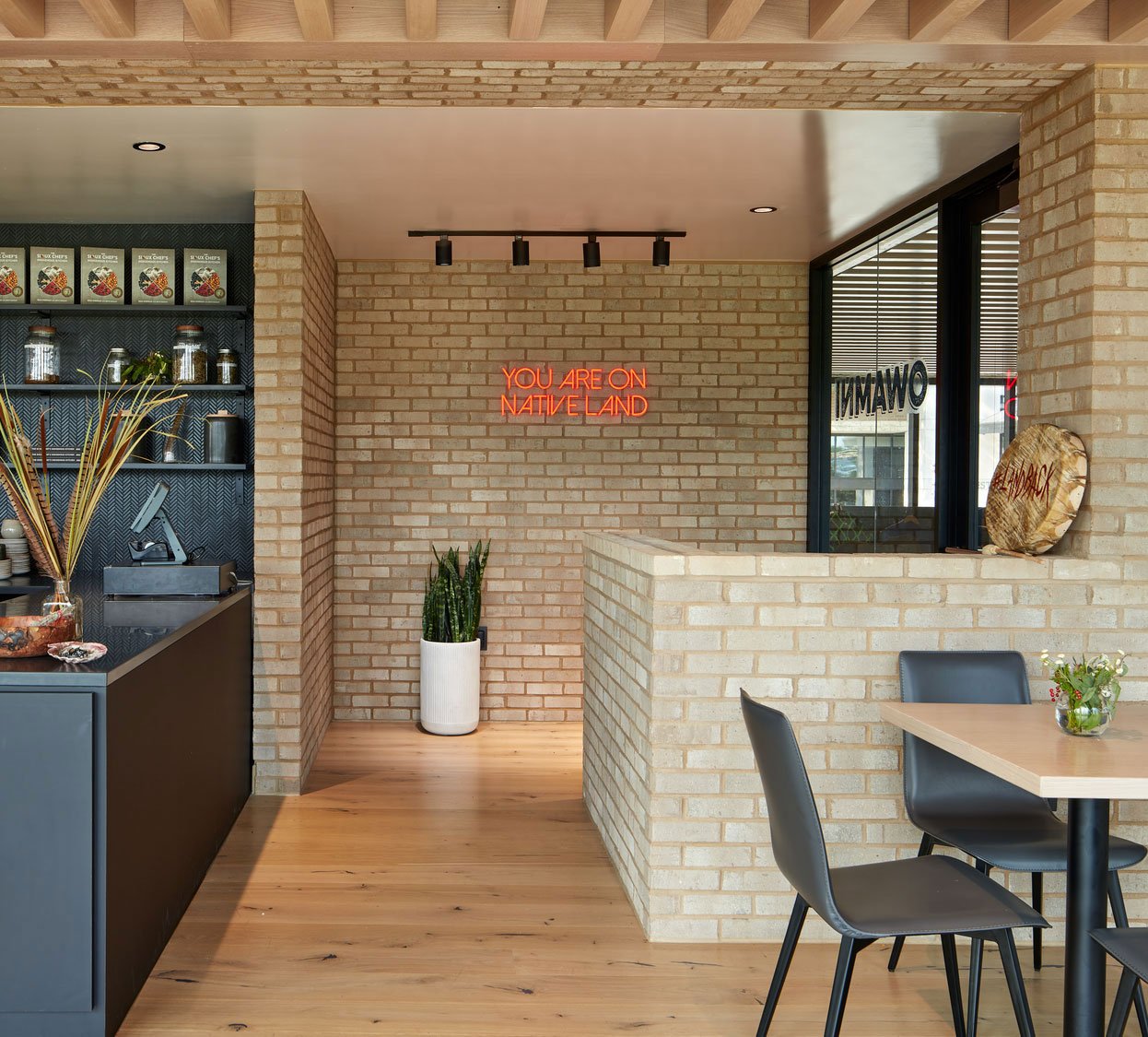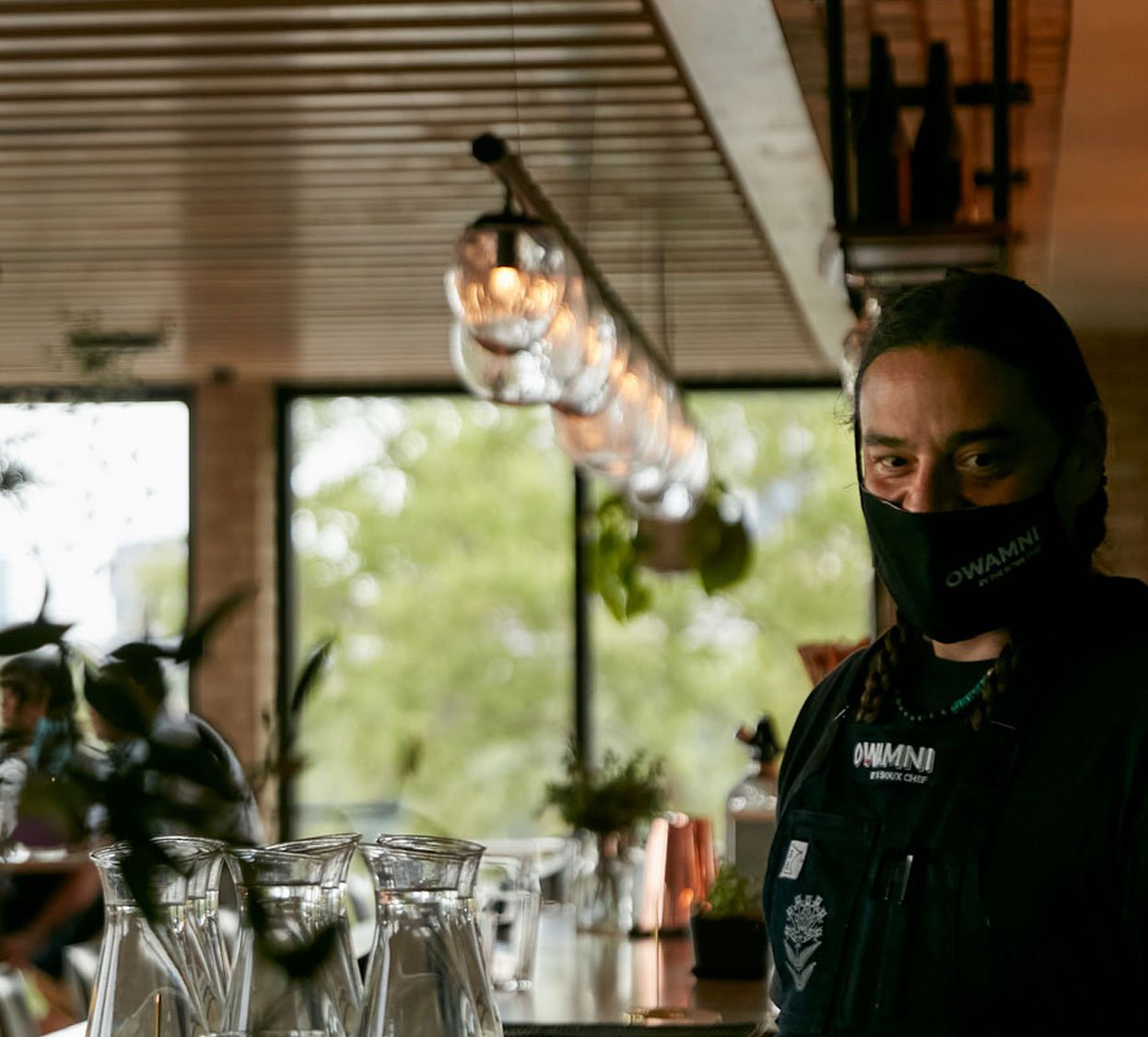
Chrysanthi Stockwell takes us to the intersection of contemporary and traditional.
As part of a plan to revitalize the iconic St. Anthony Falls, a new three-acre site is now home to acclaimed restaurant Owamni. Founded by the James Beard Award-winning chef Sean Sherman and co-owner Dana Thompson, Owamni is bringing Indigenous Native American cuisine to the Twin Cities. In addition to honoring traditional cuisine, the restaurant also focuses on sourcing ingredients from Indigenous producers first. As the menu introduces new patrons to decolonized cuisine, the space also is a platform for Indigenous education and food access. Mixing urban design with historical context, the architecture and engineering firm HGA was commissioned with many of the project’s key designs. We were lucky to talk shop about lighting design with Chrysanthi Stockwell, senior lighting designer at HGA.


HM: What was the inspiration behind the lighting design for the Owamni space?
CS: We wanted to celebrate a refined blending of modern surfaces with historic building materials. Since public safety was our first concern, we leveraged lighting to guide our guests within the space. Lighting reinforces centers of gathering and refuge. By lighting at both vertical and horizontal planes, we were able to incorporate facial recognition and a safe flow throughout the space. Areas of variation and hospitality exist within brightness and uniformity. Outside views reveal the beautiful warmth within, inviting guests upstairs.
We leveraged lighting to guide our guests within the space. Lighting reinforces centers of gathering and refuge. Areas of variation and hospitality exist within brightness and uniformity. Outside views reveal the beautiful warmth within, inviting guests upstairs. Visitors enter an enveloping wash of inground lights illuminating brick arches. 2400K to 3000K LED sources evoke the feelings of comfort and warmth and contrast is leveraged for interplay of the wood, gypsum and masonry planes.
The upper level was designed exclusively for Owamni by The Sioux Chef, a modern, Indigenous restaurant revitalizing Native American cuisine. The lighting again reinforces the blend of contemporary and traditional. A perimeter wood slat system emits a beautiful glow in the evenings due to a custom designed ceiling lighting solution that is both subtle and delightful. The Hennepin Made light at kitchen creates energy.
A warm beacon on the Mississippi, Water Works Park Pavilion lighting showcases the complex integration of old and new.
Chrysanthi Stockwell, senior lighting designer, HGA

HM: Was your initial idea based on our Foliole light? Or did you have a concept already that you could weave it into?
CS: In the early stage of discussion for the Owamni space, we were attracted to the natural elements of river stone and glass. We also looked at the repetition of ‘imperfect’ beads or river pebbles. The marrying of raw materials of textured glass and metal was intrinsic to this building and fit within the historical context. I wanted the bar light to be a timeless piece that featured light filtering through raw and refined material. I also wanted this piece to show a sparkle to attract our eyes to the hub of activity at the bar and kitchen.
HM: I noticed the scale of the glass pieces varied and wondered what was behind it.
CS: The flattened smooth shape of the Foliole design produced a rippled texture that allows a beautiful light to filter through the texture of the glass. I wanted to emphasize the varying natural orbs similar to what we find in the river pebbles or beads. When the glass pieces are aligned they work in unison but bring their own unique character.
Chrysanthi Stockwell, senior lighting designer, HGA
On architecture and historic preservation with Jean Garbarini.
HM: How much of the architectural design needed to preserve the history of the building and the geographic relationship to the river? If so, was it influenced by how the space was occupied when it was built, or was it how the space was before settlers were building on the river?
JG: The site is protected by the St. Anthony Historic District, and the former mill structures are contributing features to the district. The design intentionally rehabilitated the stone structure to allow visitors to see the craftsmanship of the historic walls, and inserted the new lobby space into an area of the structure where the stone walls had been removed years ago. The site is the location of three former mills, in the area that is the birthplace of Minneapolis’ influential milling industry. Prior to the Industrial Revolution, the site was used by Native Americans. Then, as well as today, the location on the Mississippi River near St. Anthony Falls, remains an important cultural place for the Dakota and Ojibwe peoples.
HM: There is a sign in the space stating “We are on native land”? How did this thought play a role in the design of the environment?
The Mill ruins and related history are easily visible throughout the site, and the design team sought to communicate the less visible Indiginous cultural significance. Staff from Owamni worked with the landscape architects to develop interpretive signage throughout the project communicating the cultural, medicinal and culinary significance of the plant material used. Dakota linguists and artists were engaged by the design team to develop interpretive engravings on bench tops and other elements throughout the site. The project has become a Dakota language learning site.
Jean Garbarini, Damon Farber

